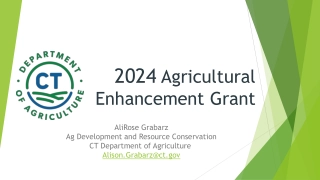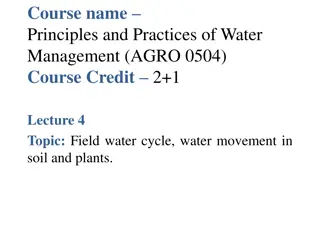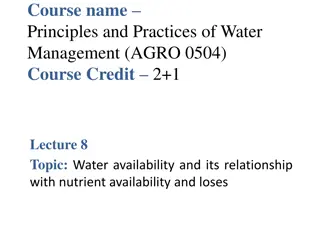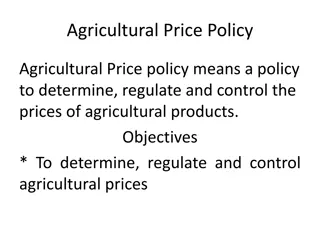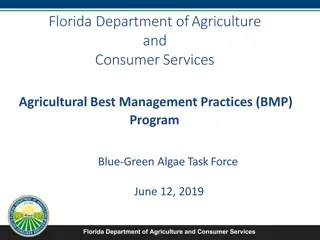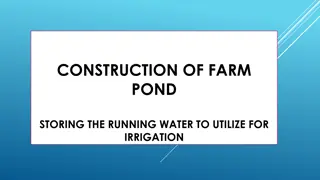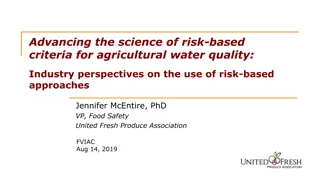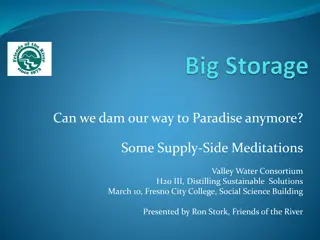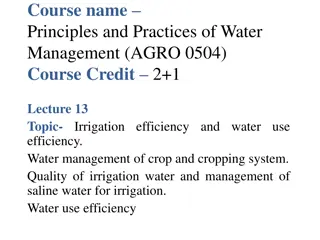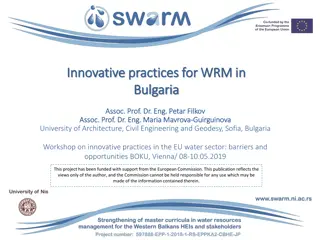Best Practices for Water Management in Agricultural Settings
Exploring various Best Management Practices (BMPs) for water management in agriculture, this content delves into definitions of detention and retention, EAA farm P load calculations, rainfall detention BMP goals, water detention methods, and mixed crop rotation strategies. The information covers reducing water pumped off-farm, managing P concentration and soil subsidence, addressing risks to crops from higher water tables, and implementing processes like evapotranspiration, water transfer, and use of water-tolerant crops. Overall, it emphasizes the importance of sustainable water management in agricultural operations.
Download Presentation

Please find below an Image/Link to download the presentation.
The content on the website is provided AS IS for your information and personal use only. It may not be sold, licensed, or shared on other websites without obtaining consent from the author.If you encounter any issues during the download, it is possible that the publisher has removed the file from their server.
You are allowed to download the files provided on this website for personal or commercial use, subject to the condition that they are used lawfully. All files are the property of their respective owners.
The content on the website is provided AS IS for your information and personal use only. It may not be sold, licensed, or shared on other websites without obtaining consent from the author.
E N D
Presentation Transcript
Water Management BMPs M. VanWeelden, S. Swanson, T. Lang, J. Bhadha, R. Rice Fall BMP Workshop Everglades Research and Education Center Sept 28, 2017
Definitions Detention: temporarily holding water until conditions for release are met; object is to control discharge rates to reduce impact on downstream receiving systems. Retention: preventing water from discharging into receiving waters; water is held until it is lost to percolation, evapotranspiration or evaporation. EAA water management is a combination of detention and retention
Rainfall Detention BMP Goal: reduce volume of water pumped off-farm Benefits: reduced P concentration and soil subsidence Risks: higher water tables may harm crops and reduce yields Processes: ET, water transfer, water-tolerant crops Unknown: subsurface drainage/seepage shellrock Completely farm-specific
EAA Farm P Load Calculation Farm P Load = Volume x Concentration Reduce volume pumped off farm Rainfall: amount and distribution Drainage needs of crop Irrigation methods, quantity, capacity Seepage into and off farm Lower concentration of P in drainage water Soil oxidation (subsidence) Irrigation water quality Fertilizer use efficiency Cover and rotational crops
Water Detention Methods Rainfall detention Selected fields with high/low water tables Booster pumps, gates, culverts On-farm water storage areas Retention ponds Seasonally flooded fields or blocks Higher water tables across whole farm Use of water tolerant crops/varieties Regulated pumping practices
Mixed Crop Rotation 1750 acres 46 fields 2 main farm pumps Sod Leaf Cane Back of farm too wet High P loads Need to over-drain large areas of the farm to achieve desired WT levels at back of farm Load = Volume * [P]
Sod Leaf Increased farm canal capacities Cane Lower P loads Can pump less after improving drainage control for specific fields
Installed booster pumps Sod Leaf Cane Still Lower P loads Routing drainage water internal to the farm can greatly reduce reliance on main farm pump.
Coordinate crop rotations within contiguous field blocks Install water control structures to allow independent WT management Drain veggies fields first, then operate main discharge pumps only if needed Plant rice in fallow fields during wet season; reduce need for off-farm pumping Sod Leaf Cane Lowest P loads Hydraulic blocking of like crops + independent WT control achieves the greatest potential for reducing off-farm drainage loads
Water Management BMPs Recirculation Enables the cultivation of higher P requiring crops without greatly impacting discharge water quality by rerouting high P water Especially important for rice drawdown waters Hydraulic Canal Dredging Relocation of canal bottom sediments and particulate matter into fields by intensive targeted pumping (canal cleaning)
Field Drainage Process Deep Soil Soil Marl Caprock Shell rock Soil Marl Caprock Shallow Soil 1 Shell rock Shallow Soil 2 Soil Marl Caprock Shell rock
Field Drainage Process Soil Marl Caprock Organic sediment Shell rock Mineral sediment velocity = (drainage flow rate)/(canal cross-sectional area) m/sec = (m3/sec)/(m2)
Rice BMPs Rice is typically grown in bunded fields that are continuously flooded up to 7 14 days before harvest Continuous flooding helps ensure sufficient water and control weeds On average, it takes 1,400 L (370 gal) of water to produce 1 kg (2.2 lb) of rice in an irrigated production system (IRRI) Seasonal water input to rice fields varies from as little as 40 cm in heavy clay soils with shallow groundwater tables to more than 200 cm in coarse-textured (sandy or loamy) soils with deep groundwater tables. For muck soils somewhere in between depending on thickness Irrigated rice receives an estimated 34 43% of the total world s irrigation water, or about 24 30% of the entire world s developed fresh water resources (IRRI).
To effectively and efficiently use water and maximize rice yields, the following good water management practices can be followed: 1. Construct field channels to control the flow of water to and from your field 2. Till the land to minimize water loss (or create a hardpan) Prepare land to be laser leveled retain soil moisture (raise water table) 3. Level the field Avoid ponding, or raised patches well-leveled field is crucial to good water management 4. Construct levees and fix any cracks or holes Rice is extremely sensitive to water shortage (below saturation) at the flowering stage. Drought at flowering results in yield loss from increased spikelet sterility, thus fewer grains
Water Management Impact on Rice Yields and Drainage Water Quality in the EAA Background Everglades Forever Act, mandates a 25% P load reduction from the EAA basin when compared to the pre-BMP Effects of mandatory BMPs in the EAA have shown improved water quality from sugarcane farms Discharges from rice farms have not been thoroughly evaluated Rice production has increased by more than 70% since 2008 Water quality impacts? Production challenges (Rice yield and rice water weevil)? Rice acreage and yields on the rise
Different crop establishment methods require different water management practices: Continuous flooding Alternate wetting and drying (AWD) Continuous flooding of water generally provides the best growth environment for rice. For direct seeded rice, field should be flooded only once the plants are large enough to withstand shallow flooding (3-4 leaf stage). If transplanting, water levels should be around 3 cm initially, and gradually increase to 5 10 cm (with increasing plant height) and remain there until the field is drained before harvest. For direct seeded rice, keep the soil moist but not saturated, to avoid seeds from rotting in the soil. After sowing, apply a flush irrigation to wet the soil, if there is no rainfall. Saturate the soil when plants have developed 3-4 leaves. AWD can be started a few weeks (1-2) after planting. Irrigate and then allow the water depth to drop to 15 cm below the surface. Once the water level has dropped to 15 cm below the surface, re-flood the field to a depth of 5 cm above the surface and repeat.
Experimental Design Study was conducted at the Everglades Research and Education Center Summer of 2014 and 2015 Two dominant rice varieties in the EAA were selected, Cheniere and Taggart Sowing method was dry-seeding with 112 kg/ha of FeSO4at a 2.4 ha field and no other fertilizer was applied Flooding started 20 days after planting Water treatments: 15 cm continuous flood (CF15) 5 cm continuous flood (CF5) 15 cm flood with drawdown (DD15) 5 cm flood with drawdown (DD5) Four replications Plots were flooded by canal water
Total P and total dissolved P concentrations were reduced in both years by 42% and 38%, respectively 15 cm flood always had higher reductions of total P and total dissolved P than 5 cm flood Drawdown did not show any significant effects on water quality parameters Inflow 15cm Continuous Flood 5cm Continuous Flood 15cm Flood with Drawdown 5cm Flood with Drawdown Particulate Phosphorus (PP) Total Dissolved Phosphorus (TDP)
2015 2014 Treatment CF15 CF5 DD15 DD5
Thank you Matthew VanWeelden, Ph.D. UF / IFAS Extension mvanweel1@ufl.edu 561-996-1656



